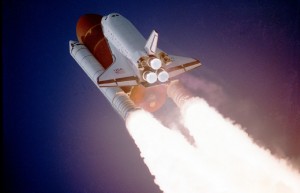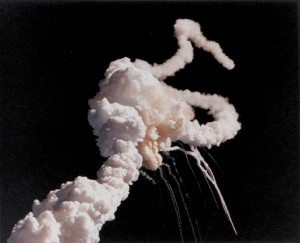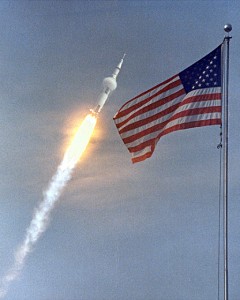Before diving into a detailed content analysis of contemporary space-related headlines, let’s take a look at each program in-depth.
Apollo
The Apollo program was first introduced to the public on May 25, 1961, when president John F. Kennedy proposed the impossible. Despite Kennedy’s insistence that the goal of landing men on the moon should not be considered an adversarial “race” with the Soviet Union, the announcement came on the heels of the first successful orbit of earth by a human. Indeed, only one month earlier Yuri Gagarin traveled around the world in the Soviet Vostok 1 spacecraft. This Cold War-era tension underscored the much of the news narrative of early space exploration, and this research will address the aspect of international relations.
Over its eleven year run, the Apollo program consisted of 11 manned flights and 22 unmanned flights used to test launch vehicles for manned missions. Of these 11 manned flights, five missions successfully landed men on the moon and brought them safely back to the earth. Propelled into space by high-powered Saturn liquid rockets, these missions involved manned command modules orbiting the moon while lunar landing modules landed on the surface. The capsules would then make the return trip to the earth and plummet through the atmosphere and into a body of water.
Space Shuttle

Space Shuttle Atlantis (STS-27, 12/2/1988) ascends with secret military cargo that the New York Times reported as a spy satellite.
Unlike the Apollo missions, the Space Shuttle never exited low earth orbit. The idea of space shuttles as means to develop space stations existed as far back as the pre-lunar landing era. In fact, as early as 1966 NASA had been investigating the feasibility of a reusable spacecraft system to develop such orbiting stations. Ultimately, the first manned Space Shuttle mission occurred on April 12, 1981. Over the next thirty years, a fleet of five shuttles flew 135 missions to low earth orbit.
Over the years, the Space Shuttle program has conducted scientific missions, secret military missions (usually to deploy spy satellites, especially during the Cold War), satellite maintenance missions, and missions dedicated to constructing and maintaining space station outposts.
Why compare coverage of these programs?
The impetus for this project came in the summer of 2011, after Space Shuttle Atlantis undocked from the International Space Station for the final time. America’s fleet of venerable shuttles had flown their last missions, and the only way to space was to hitch a ride on a Soyuz capsule at a cosmodrome halfway around the world. A thirty-year period of U.S.-led space exploration had finally drawn to a close.
With the end of the Space Shuttle program came an end of an era. And while this was sad news for many stargazers, it was essential for this content analysis. Because both the Apollo and Space Shuttle eras are over, a longitudinal analysis can be conducted and conclusions may be drawn.

Space Shuttle Challenger (STS-51-L, 1986) explodes 1:13 after takeoff. Both the Apollo and Space Shuttle programs encountered times of emergency and disaster that shaped coverage.
Additionally, both programs share a few key features that dictated the nature of news coverage. First, both had their fair share of heartache and drama. The Apollo program met disaster early in its lifetime when, in January 1967, Apollo 1 suffered from a cabin fire during a launch pad test, killing all three astronauts on board. Three years later, NASA would find itself in even more of a public relations nightmare when an oxygen tank exploded aboard Apollo 13, leaving the crew with a severely damaged return craft.
Similarly, the Space Shuttle program had to deal with disaster of its own. The 1986 Challenger disaster and the 2003 Columbia disaster combined to take the lives of 13 Americans and one Israeli. By addressing media coverage after these mission failures, this research aims to describe general trends in space coverage after disaster.
In addition to the finite nature of each era and the disasters that plagued certain missions, the status of the American economy at the end of each era is necessary to note. The Apollo and Space Shuttle programs ended as the American economy was in recession.
Originally, there were supposed to be three additional lunar missions. In 1970, following a contentious battle for funding in Congress, Apollo 15, 19, and 20 were canceled. The remaining missions were renamed, with Apollo 17 slated to be the final lunar flight. While the Space Shuttle program ran its 30 year course, the original intention – to have more regular voyages into the heavens – was not realized. And despite requests from NASA officials for a larger piece of the budgetary pie for additional missions, the program ended (along with the jobs of thousands of residents on Florida’s east coast).
Research Questions
Primarily, we’re seeking answers to the following questions:
1. Was either program treated with more fanfare or skepticism?

The Apollo 11 crew is welcomed by a ticker tape parade in Chicago. Apollo 11 was the first mission to land on the moon in July, 1969.
It’s no secret that people in the 1960s were a bit “moon crazy.” When Neil Armstrong, Buzz Aldrin, and Michael Collins took their historic moon shot in 1969, 500 million were estimated to have been glued to their television sets. At Apollo launches, the rich and famous ventured to Cape Kennedy to glimpse man piercing the sky. And during the lunar missions, the makers of “moon cheese” reported heavy demand.
But for all the fanfare associated with Apollo, there were also pangs of skepticism and worry that such a financial investment would have been better used closer to home. Especially as the lunar missions came and went, fewer and fewer people embraced the project. Fewer people tuned in to watch launches and moonwalks, fewer reporters showed up to cover NASA activities around launching, and there were even protests in the early 1970s decrying the budget priorities of Congress.
The Space Shuttle program has fostered its share of skepticism, as well. While much of this second-guessing was a product of the 1986 and 2003 shuttle disasters, there was a healthy dose of criticism among the public at the beginning and end of the program.
2. Has there been a decline in narrative storytelling that has portrayed astronauts as heroes rather than routine mission specialists? Have astronauts been “dehumanized” in the eyes of the media?
We all know the names Neil Armstrong and Buzz Aldrin. You might even be familiar with Michael Collins, the command module pilot who spent a day in utter solitude orbiting the moon while Armstrong and Aldrin stepped on the moon. But are you familiar with Christopher Ferguson, commander of the final Space Shuttle mission (STS-135)?
It seems as if modern astronauts, with some notable exceptions, are anonymous NASA personnel compared to the first, near-celebrity astronauts. This analysis seeks to determine whether news coverage of missions reflected such a shift.



